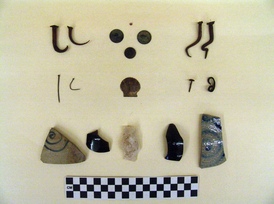Latting's Hundred
Built in 1653, Latting's Hundred sheltered a succession of Long Island merchants and stood witness to private and public affairs of generations of African Americans. Among the best documented African American families of the time, Rachel, her son Peter, niece Sarah and nephew Elijah all lived and worked in this house from 1739 to 1792. Surviving records and artifacts speak of their African origins and daily lives. In the years to follow, pursuant to the New York State Manumission Act of 1799, many local African Americans came to this same house to obtain "Freedom Papers."
Rachel, born in 1713, managed both house and inn for the Lewis family, owners of Latting's Hundred. Her son Peter grew up with the Lewis children and served as butler. He was pressed into the British Army as a teamster with Gen. Sir William Erskine's Brigade during the Revolutionary War. Elijah, a musician at the inn, was wounded while defending the home next door against British soldiers. He became a local celebrity and the story of the man with the "bulletproof head" is still retold.
Artifacts bundled together and pressed between sill and floor of the home were found during a restoration and date to this period. The contents may represent Rachel's heritage as the bundle reflects African religious practices.
Prominent politician and merchant Samuel Fleet lived here in the early Nineteenth Century. His public duties included the review of petitions to emancipate adult bondservants. He signed seventy percent of the manumissions issued to African Americans in the Town of Huntington, Long Island.
This entry contributed by the
Center for Public Archaeology at Hofstra University
Related Media
Images

|
The old wing long served as a general store and post office while the main house as an inn and family home. A succession of African Americans lived and worked here from 1739 until farming ceased in 1953. Today it is a private residence.
|

|
|

|
This bundle of symbolic objects was concealed in the cellar stairwell at Latting's Hundred. African Americans honoring the religious traditions of their families placed objects where they lived and worked.
|
